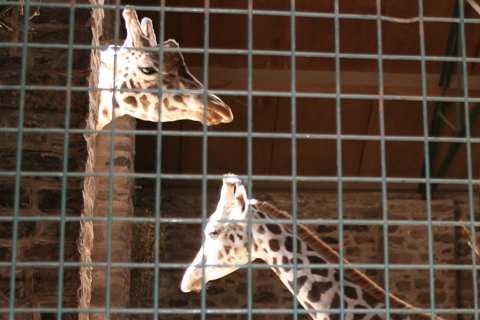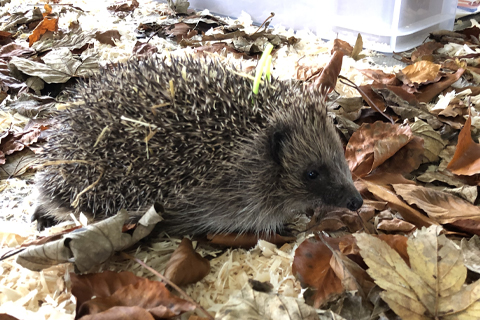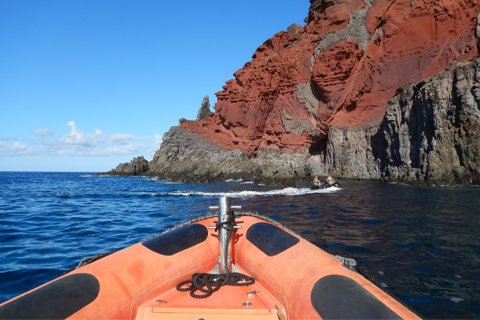Research projects and placements
Explore examples of our past research projects and conservation placements.
Examples of past research projects
Sleep as a positive welfare indicator in Rothschild’s giraffes
 Overnight behaviour is increasingly being studied in zoos with sleep duration indicative of positive welfare in a range of species. The aim of this project was to investigate if noise associated with out-of-hours events at Chester Zoo impacts the sleeping patterns and social behaviours of Rothschild’s giraffes. By working closely with scientists at the zoo we were able to study night-time camera footage, comparing the behaviours of the giraffes on evenings with and without events. This analysis allowed us to conclude that evening events were not significantly impacting the welfare of the Rothschild’s giraffes as similar patterns of REM sleep and nocturnal social behaviours were observed.
Overnight behaviour is increasingly being studied in zoos with sleep duration indicative of positive welfare in a range of species. The aim of this project was to investigate if noise associated with out-of-hours events at Chester Zoo impacts the sleeping patterns and social behaviours of Rothschild’s giraffes. By working closely with scientists at the zoo we were able to study night-time camera footage, comparing the behaviours of the giraffes on evenings with and without events. This analysis allowed us to conclude that evening events were not significantly impacting the welfare of the Rothschild’s giraffes as similar patterns of REM sleep and nocturnal social behaviours were observed.
Identifying triggers of hibernation to protect hedgehogs
 This project explored environmental triggers and behaviours in European hedgehogs around the hibernation period. Four hedgehogs were housed overwinter in an extensive, semi-naturalistic enclosure with ad libitum food availability. Light intensity and duration, temperature and humidity were continuously monitored and recorded, with movement and behaviour monitored using radiofrequency tracking and motion-sensitive cameras. Despite being exposed to identical environmental conditions, there was variation in whether hibernation occurred or not, time of onset and emergence from hibernation and number and timing of arousals. Nest sharing was frequently observed and food was consumed during arousals. Hibernation appears to be a complex, multifactorial phenomenon.
This project explored environmental triggers and behaviours in European hedgehogs around the hibernation period. Four hedgehogs were housed overwinter in an extensive, semi-naturalistic enclosure with ad libitum food availability. Light intensity and duration, temperature and humidity were continuously monitored and recorded, with movement and behaviour monitored using radiofrequency tracking and motion-sensitive cameras. Despite being exposed to identical environmental conditions, there was variation in whether hibernation occurred or not, time of onset and emergence from hibernation and number and timing of arousals. Nest sharing was frequently observed and food was consumed during arousals. Hibernation appears to be a complex, multifactorial phenomenon.
Saving the critically endangered terrestrial gastropod Discula lyelliana on the Desertas Islands, Madeira
Anthropogenic introduction of invasive species has significantly reduced its population. D. lyelliana was only previously observed in 1852 until a remnant population was rediscovered in 2012. The persistence of threats led to a rescue program in 2021. There is now a large, successfully breeding, biologically isolated captive  population at Chester Zoo. After successful eradication of invasive species from Bugio Island, a reintroduction is planned for late 2024. Bugio island harbours other species of conservation importance, including wolf spiders (Hogna spp.), Desertas petrel (Pterodroma deserta) and other terrestrial gastropods. Therefore, reintroduction poses a risk to affect all these species through novel pathogen introduction. As such, a pre-release health screening was carried out.
population at Chester Zoo. After successful eradication of invasive species from Bugio Island, a reintroduction is planned for late 2024. Bugio island harbours other species of conservation importance, including wolf spiders (Hogna spp.), Desertas petrel (Pterodroma deserta) and other terrestrial gastropods. Therefore, reintroduction poses a risk to affect all these species through novel pathogen introduction. As such, a pre-release health screening was carried out.
Thirty D. lyelliana specimens were taken from Chester Zoo and a further 30 specimens of an abundant proxy species (Discula polymorpha poromphala) were collected from Bugio. Hence, a full disease risk assessment based on these findings and involving all stakeholders, should follow. The health screening of wild-caught D. polymorpha detected renal trematodes, rickettsia-like organisms, and intracellular parasites, and numerous, likely commensal gastrointestinal bacteria, adding to the sparse knowledge of wild gastropod health and disease.
Parasitology and bacteriology were carried out on faecal and apex samples. Fixed specimens were processed following standard histology procedures, stained with gram, periodic acid–Schiff, Ziehl-Nielsen, Giemsa and haematoxylin and eosin stains and examined by a boarded vet pathologist. Findings observed in the captive population only, and hence those which pose a risk of novel disease introduction, included an unidentified nematode, annelid, mite and bacteria including Aeromonas spp. Mild histopathological findings included nephropathy, fungal nephritis, fungal pneumonia, few intestinal nematodes and mantle abnormalities. Although none appear likely to cause disease, there is uncertainty given the lack of knowledge on terrestrial gastropod pathogens and the presence of unidentified organisms.
Examples of past conservation placements
- Bird ringing as a tool in seabird conservation on Ramsey Island RSPB Reserve, Wales
- Beaver reintroduction for habitat restoration in Hatchmere Nature Reserve
- Improving captive management through post-mortems at Chester Zoo
- Predator control to protect wetland birds at RSPB Burton Mere Nature Reserve
- Communicating science to make habitat connectivity software accessible to policy makers and conservation managers
- Red squirrel monitoring to assess squirrel pox as a conservation threat in Formby National Trust Nature Reserve
- Surveying hazel dormice and water voles to inform their management with Cheshire Wildlife Trust.